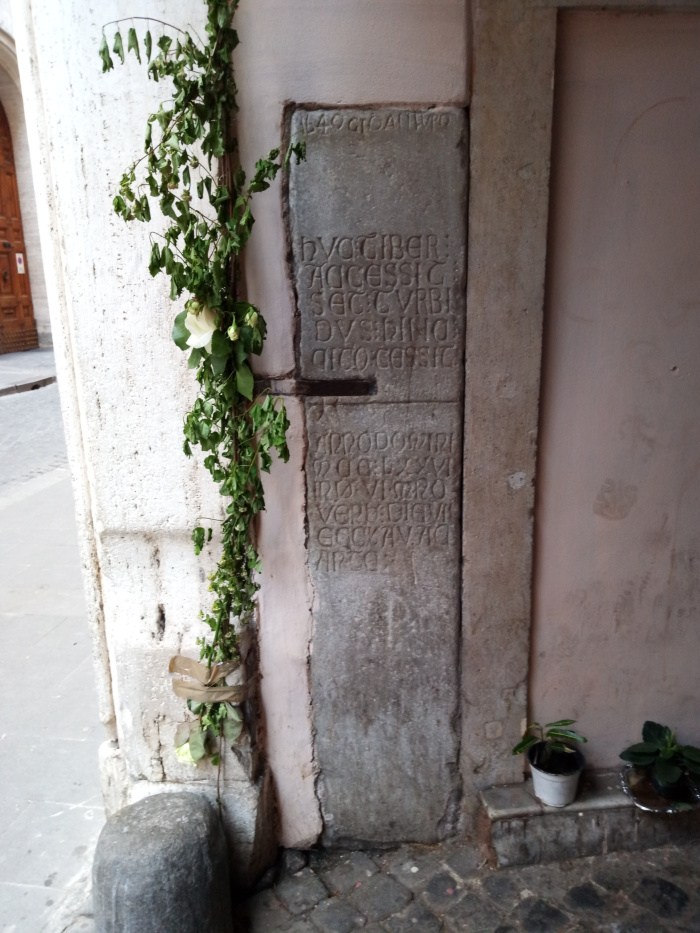
According to a Latin motto “repetita juvant”, “it is useful to repeat things”. That’s why I will never be too tired to tell you that Rome is a city that never ends: even in the most unthinkable places this generous city will offer you a chance to learn about it. For example, on the walls.
If you’re mindful even outside museums and archaeological sites, walking through Rome you will come across commemorative plaques of this kind:
The flood of 28 December 1870 was one of the most devastating in Rome and, significantly, it occurred near the Unification of Italy. Impressed by the frightening spectacle of the waters of the Tiber, exceeding 17 meters, the new sovereigns decided to put an end once and for all to the flooding of the urban stretch of the river.
Therefore, from 1876 to 1926 the so-called “muraglioni” (very high embanking walls) of the Tiber were built.
An enormous work that on the one hand still today keeps the city dry, but on the other has also broken the relationship that the Romans have always had with the river. If we consider the name “Rome” itself most likely comes from the Etruscan R(u)M(on) which means “the city on the river”, we can well understand how much the Tiber was decisive for the development of the city, despite its devastating floods.
We also should remember that, according to the legend, the basket of the twins Romulus and Remus was carried by the outflow of the river and that the name Romulus comes from Rome, not vice versa. You’ll find many of these plaques right in the area of Vincenzo’s store as the area near the Pantheon is one of the lowest of Rome. On the facade of the Church of S.M. sopra Minerva indeed, the one in front of the elephant designed by Gian Lorenzo Bernini, right behind the Pantheon, many plaques mark the impressive levels of water during the centuries.
My grandma Vittoria, who was born on July 4, 1926, still remembers the last Tiber flood in December 1937 because she lived in Via dei Giubbonari, near Campo de’ Fiori and from her house it was very easy to “go and see the river” as if the Tiber was a relative to visit in order to verify its state of health (by the way, we continue to do this if it rains for many days). She remembered that the people on the bridges worried the Tiber Island “could not be seen anymore!” as it was completely submerged under a torrent of water. However, even if those visions certainly awakened ancient fears in the Romans soul, thanks to the “muraglioni”, the damage was modest. The plaque of this last flood is right on the Tiber Island, on the wall of the Fatebenefratelli Hospital, while the oldest plaque that attests a flood is now located under the arch of Via dei Banchi Nuovi.
The flood plaques are still visible on the walls of Rome, according to some sources, there are about 88. I have been able to identify some of them in my area and here are the addresses. If you are able to find more, please let me know!
Piazza Sant’Apollinare (on the facade of Palazzo Altemps)
Church of S.M. della Pace (next to the central door jambs)
Corso Rinascimento (on the side of Piazza Navona)
Piazza Sant’Eustachio (on the facade of the church)
Church of S.M. sopra Minerva (on the facade of the Church)
Via della Pigna (just after Palazzo Maffei-Marescotti)
Via dei Redentoristi (where the street gets smaller)
Via dei Pastini (next to the entrance of a restaurant)
Via dei Sediari (on the corner with Via del Teatro Valle)
Ps: the highest remembered flood is the one of December 24, 1598. The water of the river reached 19.56 meters (1 meter = 3,28 ft). A popular legend says that this flood left in Piazza di Spagna a “Barcaccia”, a boat broken by the fury of the waters that Pietro Bernini, Gian Lorenzo’s father, carved forever in marble 30 years later.


Federica



